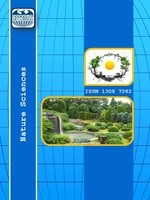3B GRAVİTE HESAPLARIYLA DOĞU PONDİTLERDE KABUK ÇALIŞMASI
Doğu Karadeniz Bölgesi‟nde kabuk yapısı ve moho derinliği üç boyutlu gravite ters çözüm modelleme yoluyla tespit edilmeye çalışılmıştır. Öncelikle çalışma bölgesinde yedi tane profil belirlenmiştir. Üç boyutlu çalışmada tabaka yüzeyleri üçgen yüzeylere bölünerek tanımlanmıştır. 3B model hesaplarıyla bu bölgede yedi ayrı profil altında, ilk olarak Karadeniz suyu birinci kütle ve ortalama yoğunluk kabulüyle, kabuk ta ikinci kütle olarak alınmıştır. Karadeniz suyunun gravite etkisi suyun mutlak yoğunluğu ile hesaplanarak, ölçülen Bouguer anomali değerlerinden çıkarılmıştır. Daha sonra sedimanter kayaçlar da ters çözüm hesaplarına dahil edilerek modellemede üç kütle kullanılmıştır. Hesaplanan yoğunluklar kabul edilebilir sınırlar içinde kalacak şekilde, yedi profil altındaki sınır değerleri en optimum derinliklere çekilerek ters çözüm hesapları tekrarlanarak en olası sedimanter kayaç derinliği ve moho sınırları tespit edilmiştir.
Anahtar Kelimeler:
Gravit, 3-B Modelleme, Derinlik, Kabuk Yapısı, Moho
CRUST STUDYING IN THE EASTERN PONTIDES BY 3D GRAVITY ALGORIHM
Structure of crust and moho depth have been determined in the eastern Black Sea region by three-dimensional gravity inversion modeling. First, seven profiles have been determined in the study area. The surfaces of layer were defined to divide by triangle surfaces in three-dimensional study. Three-dimensional gravity inversion was calculated by using a special algorithm for these model geometries by intensity of adoption. Under the seven different profiles in this region by 3D model accounts, as the first Black Sea water mass and average density of acceptance, also crust were accepted as the second mass. The gravity effect of black sea water was calculated with water absolute intensity, then have been removed from measured Bouguer anomaly values. Then, also sediment was included to inversion account and the three masses were used in the model. The calculated densities to be within the acceptable limits, by the boundary values under seven profiles were drawn to the optimum depths, by inversion accounts were repeated, the most likely depth of sediment and moho borders have been determined.
Keywords:
GRAVITY 3D MODELING, DEPTH, CRUSTAL STRUCTURE, MOHO, ,
- Başlangıç: 2009
- Yayıncı: E-Journal of New World Sciences Academy
